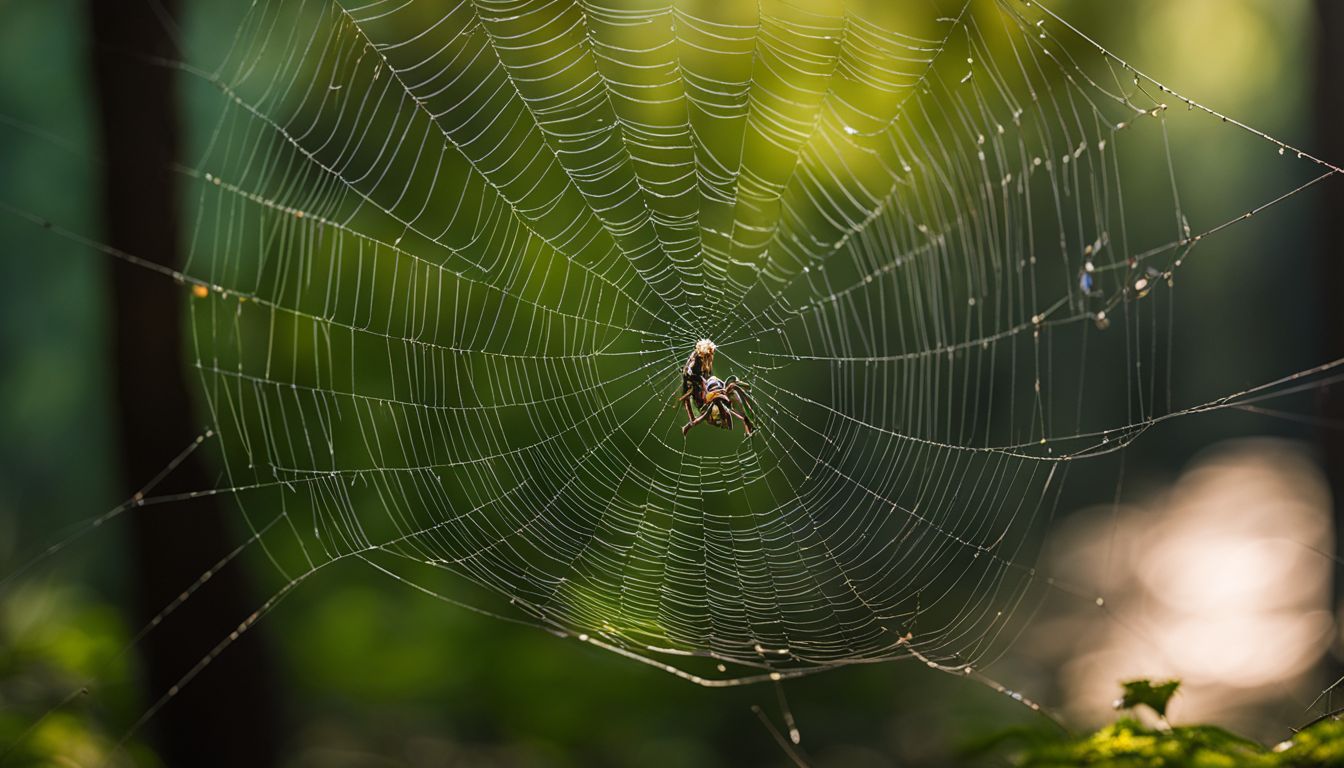Have you ever wondered if a spider can get high just like humans? Believe it or not, these tiny creatures can experience altered states when exposed to psychoactive substances. Our blog post dives into the curious world of spiders on drugs and the surprising effects it has on their web-building skills.
Stick around; it’s going to be an intriguing crawl into spider science!
Key Takeaways
- Spiders can experience altered states when exposed to psychoactive substances like marijuana, caffeine, and LSD, leading to changes in their web-building patterns.
- Studies on spiders’ reactions to drugs offer valuable insights into the effects of mind – altering substances on animals, providing a simpler model for understanding drug impacts on neurological systems.
- Comparing spider reactions to human responses to similar drugs shows parallels in changes in activity level, perception, and task performance. This offers an intriguing model for comprehending the effects of these substances on the complex human brain.
The Fascinating World of Spiders, Their Webs, and Strength

Moving from the curious world of spider behavior under influences, let’s explore spiders and their incredible webs. Spider silk is an amazing substance. This silk can stretch and hold a lot of weight, even more than steel if you compare them by thickness.
Spiders make many different kinds of threads with this silk. They use it to catch food, make homes, and protect themselves.
The way spiders spin their webs is very clever. Each thread sends vibrations along the web that tell the spider all about what’s happening: if there’s food caught or danger coming.
Silk helps spiders survive in lots of ways; they can even use it to fly through the air like kites on windy days.
Spiders show us how nature makes strong things in small packages. Their webs are wonders that combine power with purpose – something we learn more about every day!
Historical Experiments on Spiders and Drugs

The Origins: Peter N. Witt’s Experiment
Dr. Witt wanted to know how drugs could change spiders’ behavior, so he gave them different kinds like caffeine and LSD. He watched closely as the spiders spun their webs after taking these substances.
His work showed that the drugs made it hard for spiders to do a task they needed for survival: building webs. This was big news because it helped us understand more about how drugs affect brain and body actions in small creatures like spiders.
NASA’s Follow-Up Studies
Building on Peter N. Witt’s work, NASA also looked into how drugs affect spiders. They tested different mind-changing substances to see what would happen. In these tests, they gave spiders things like caffeine, amphetamine, LSD, and cannabis.
They watched the spiders closely to learn more about their behaviors. For example, one finding was that spiders on LSD made webs that didn’t look good or work well. This showed that the drugs could really change how spiders act.
Newsweek checked facts and found out it was true that NASA did this study in 1995 with psychoactive drugs and animals like spiders.
Understanding the Effects of Drugs on Spiders
Spiders have shown altered web designs and behaviors under the influence of certain drugs, providing valuable insights into the effects of psychoactive substances. Comparing spider reactions to human responses helps scientists better understand the impact of mind-altering drugs on arachnids.
Altered Web Designs Under the Influence
Spiders alter their web designs when under the influence of drugs.
- Spiders on LSD create webs described as ugly and inefficient.
- Marijuana and mescaline also affect how spiders build their webs.
- These altered web designs help scientists understand how drugs impact the behavior of living organisms.
- The study of spiders on drugs provides insights into the effects of substances on cognitive functions.
- Spiders offer a simpler model for studying drug effects compared to human subjects.
Comparing Spider Reactions to Human Responses
Transitioning from the altered web designs spiders exhibit under the influence of various substances, it is intriguing to compare their reactions to those seen in humans when exposed to similar psychoactive drugs. This comparison not only helps scientists understand the spiders themselves but also offers insight into the broader neurological impacts of these substances, potentially mirroring human responses to a certain extent. The following table outlines how spiders react to drugs in comparison to human responses:
| Substance | Spider Reaction | Human Reaction |
|---|---|---|
| Caffeine | Irregular and less structured webs | Increased alertness and, at higher doses, jitteriness and anxiety |
| LSD | More symmetrical and regular web patterns | Altered perceptions, emotions, and thoughts; visual hallucinations |
| THC (Marijuana) | Reduced web-building activity | Relaxation, altered perception of time and space, impaired short-term memory |
| Amphetamines | Increased activity but less control over web construction | Heightened energy and focus, potential for addiction and increased heart rate |
Through this table, we see that spiders and humans exhibit some parallels in their reactions to drugs, with both experiencing changes in activity level, perception, and task performance. These responses in spiders offer a valuable model for understanding the effects of these drugs on a simpler neurological system, which could then be extrapolated to comprehend their impact on the complex human brain.
The Science Behind Spiders Getting High
Spiders have been studied to understand the impact of mind-altering substances on their behavior and web designs. These studies reveal valuable insights into the effects of drugs on arachnids and their central nervous system.
The Impact of Mind-Altering Substances on Arachnids
Mind-altering substances can affect spiders in surprising ways. Researchers found that spider venom contains toxins similar to neurotoxins that can impact their behavior. When exposed to drugs like LSD or cannabis, spiders produce webs of varying quality, indicating potential changes in their consciousness.
This has raised interesting questions about the effects of these substances on arachnids and how it relates to their behavior and biology.
The study of mind-altering substances’ impact on spiders has sparked discussions among scientists about the possible implications for understanding arachnid behavior and biology. It’s fascinating to explore how these substances may influence spiders’ responses and abilities, shedding light on the complex interactions between psychoactive drugs and arachnids.
The Significance of These Studies
Understanding the effects of psychoactive substances on spiders can provide valuable insights into how drugs impact the brain and behavior of different species. These studies also highlight the importance of considering the broader implications of drug use on the environment and ecosystems.
What We Learn from Spiders’ Reactions to Drugs
Studying spiders’ reactions to drugs helps us understand how these substances affect the brain and behavior. For example, when given LSD or mescaline, spiders show changes in their web-building.
This teaches us about the effects of mind-altering substances on animals, including potential impacts on human mental health. By observing spider behavior under the influence of different drugs, scientists gain valuable insights into the neurological impacts and specific effects of various drugs.
The experiments with spiders not only provide information about drug effects but also offer a unique way to study toxicity testing and environmental monitoring. These studies help researchers recognize distinctive aberrations in spider behavior caused by different psychoactive substances, such as altered web patterns.
This knowledge could be important for understanding drug toxicity and its impact on living organisms beyond just humans.
Understanding how drugs affect animals like spiders can provide crucial information that benefits both human and environmental well-being.
Conclusion
In conclusion, spiders can get high from consuming mind-altering drugs like marijuana, caffeine, and LSD. NASA’s experiments have shown that these substances affect spiders’ behavior and web-building patterns.
Research on the impact of psychoactive drugs on animals, including spiders, provides insights into brain function and behavior. Understanding how spiders react to these substances offers valuable information for scientific study.
Discover the incredible strength of spiders and how it compares to the effects of psychoactive substances by visiting How Strong Are Spiders?.
FAQs
1. Can spiders feel the effects of drugs like LSD?
Yes, spiders can be affected by LSD (lysergic acid diethylamide). It can change their motor skills and the way they make webs.
2. What do scientists learn from giving drugs to spiders?
Scientists study how toxic chemicals like psychoactive drugs mess up animals’ bodies and minds. Spiders act as bioindicators, showing changes in behavior that help us understand more about these substances.
3. Do spiders show different reactions to different drugs?
Yes, each drug has its own effect on spiders. Like with ketamine or cocaine use disorders in humans, the reaction could be restlessness or odd movements.
4. Are there studies on whether animals try to take drugs themselves?
Some research talks about whether animals will take psychoactive substances themselves without being forced—if they act as “reinforcers.” This might tell us something about addiction.
5. Can studying spiders help people with mental health problems?
By looking at how stressors affect spider behavior, we might get clues about stress response and mental health issues in humans since many animals share similar body systems for dealing with stress.
6. Why is it bad to expose creatures like zebrafish or Oreochromis niloticus (a type of fish) to alcohol or other drugs?
When a creature’s space memory or vigilance gets worse because of things like high blood alcohol concentration, it means those substances are harmful—and not just for humans but for animal populations too.




